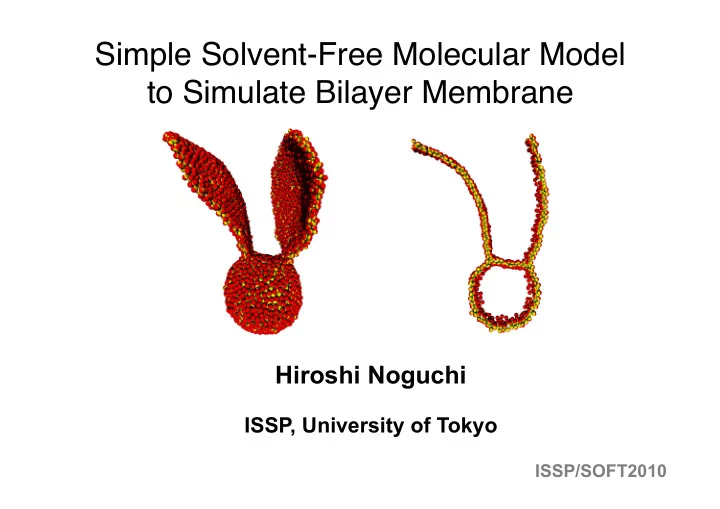

Simple Solvent-Free Molecular Model to Simulate Bilayer Membrane Hiroshi Noguchi ISSP, University of Tokyo ISSP/SOFT2010
・ Biomembrane Cell Plasma membrane 10nm ~10 µ m Large scale gap http://upload.wikimedia.org/wikipedia/commons/1/10/Illu_cell_structure.jpg
Membrane models ∼ µ m curved surface ( no bilayer structure ) Numerically faster go down molecular model length and coarse grained time scale molecule atomistic model More detailed information bottom up Shinoda etc. ~ nm Tieleman, et al. BBA 1331, 225 (1997)
● curved surface ● theory: continuous surface C 1 , C 2 : principal curvatures 、 C 0 : spontaneous curvature ● simulation: discretized surface ● mesh methods ● meshless methods A particle represents a membrane patch.
● mesh method degrees of freedom: positions and connections of particles fluid membrane by bond flip (Monte Carlo) for fixed topology works very well Ochanomizu Lecture (Aug. 23) by G. Gompper disadvantage dynamics with topological changes
● meshless methods 1) degrees of freedom: positions and orientation Drouffe, Maggs, S. Leibler Science 254, 1353 (1991). Del Popolo (2008); T. Kohyama (2009); P. Liu (2009); H. Yuan (2010). 2) degrees of freedom: only positions Noguchi and Gompper Phys. Rev. E 73, 021903 (2006). Advantage: Naturally applied to the topological changes
k α and ε dependence κ and Γ can be independently varied . area area of bending compress line tension tensionless rigidity modulus membrane 2 A / N σ 2 Γσ / T K σ / T κ / T 0 A 1.2 1.4 20 40 20 40 2 4 0 0 10 k / T ε /T=4 α 20 2 A / N σ 2 Γσ / T κ / T K σ / T A 0 1.45 1.5 18 19 20 20 40 60 4 6 2 2d 4 ε / T k α /T=10 6
Vesicle formation Very large membrane R dis / σ >> 8k α / ε Buckling into two vesicles is also possible.
● rupture ε /T= 1.5 -> 1.3 10000 < t > D / σ 2 0 rup 1000 BD MPC 100 1.2 1.3 1.4 ε /k T B Noguchi and Gompper J. Chem. Phys. 125, 164908 (2006).
curved surface 1 particle or segment > 100 lipid molecules ~ σ > thickness ~ length scale > 10 times ~ molecular model 1 coarse-grained molecule = 1~4 lipid molecules
・ Coarse-graining of lipids with explicit solvent without explicit solvent atomistic models coarse-grained models ? Klein et al. 0.1nm 0.4 nm 1nm
solvent-free molecular model for bilayer membrane H. Noguchi , M. Takasu (2001) modifications O. Farago (2003) G. Brannigan, F.L.H. Brown (2004) G. Brannigan, P.F. Philips, F.L.H. Brown (2005) I.R. Cooke, K. Kremer, M. Deserno (2005) Z.J. Wang, D. Frenkel (2005) J.D. Revalee, M. Laradji, P.B.S.Kumar (2008). M. Hoemberg, M. Mueller (2010). Only narrow parameter range Aim 1: make a model for wide parameter range
Aim 2: Coarse graining more to simulate larger scale 3 spheres 1 sphere
Continuum theory for bilayer membrane Membrane bending, area dilation, molecular tilt, chain stretching. Fournier, EPL 43, 725 (1998).
Tilt + bending of membrane tilt + bending u = n tilt only n u bending only u n Kozlovsky and Kozlov, Biophys. J. 2002
● Our new model local density
● Self-assembly Vesicle formation
surface tension tensionless membrane bilayer structure
bending rigidity κ linear dependence on k tilt and k bend
l i n e t e n s i o n o f m e m b r a n e e d g e line tension line tension
● rupture C ʼ 0 = 0 -> 0.85
● droplet-vesicle transition Bilayer is metastable at k tilt = 0.
Preliminary simulation: Membrane fusion Optical tweezers 2.5mm External force Dai et al., J. Neurosci. 18, 6681 (1998). Fusion!
Experimental studies Quick-freezing Electron Electric resistance measurement microscopy images Bars, 100 nm. V.A. Frolov et al. Biophys . J. 85, 1725 (2003). Kanaseki et al. J. Cell Biol . 137, 1041 (1997).
fusion pathways found by simulations Solvent-free models Noguchi et al. 2001 Lattice MC Mueller, et al. 2002 LJ model Marrink et al. 2003 Stevens et al. 2003 Smeijers, et al. 2006 Kasson et al. 2007 DPD model Li and Liu 2005 Shillcock et al. 2005 Atomistic model Knecht and Marrink 2007
Membrane fusion by mechanical force Pathway of modified stalk model
My previous simulation Distance between nm nanoparticles X np 30 20 10 0 5000 10000 ns Time step t Stochastically Noguchi J. Chem. Phys. 117, 8130 (2002).
Summary ○ A new CG model is proposed. ・ Minimum molecular size: a sphere and orientation ・ Membrane properties can be varied in wide range (including metastable bilayer). ・ Application: ! n o i t n membrane fusion etc. e t t a r u o y r o f u o y k n a h T Supported by KAKENHI (Grant-in-Aid for Scientific Research)
ISSP Supercomputer http://fujibakama.issp.u-tokyo.ac.jp/supercom/
Recommend
More recommend